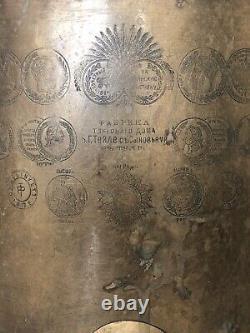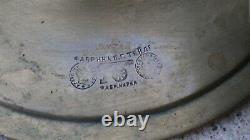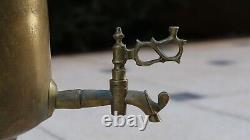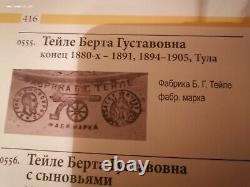Museum rare Antique Imperial Russian Brass Samovar marked 1904 duple head eagle














Of all beverages, tea alone has the proverbial power to relieve toska (pronounced TaskA, with the emphasis on the last'a'; the state similar to khandra), the sadness and melancholy which traditionally burden the Russian spirit though most Russians thinks that's a load of nonsense, they just like tea! The samovar which dispenses it is a time-honoured symbol of Russian hospitality. It stands for the hearth, the warmth of a Russian welcome, the restorative powers of a glass of tea around the stove after hours in sub-zero temperatures. So said the writer, chef and journalist Leslie Chamberlain in her, The Food and Cooking of Russia. Samovar literally means "self boiler". It's a large metal container in which water is kept hot and used for drawn out tea drinking sessions. Tea is kept in a concentrated brew in a teapot on top and is diluted with water from the main container to make cup after cup. The phrase, "to have a sit down by the samovar" means to mull things over with friends, perhaps for hours at a time. The origins of the samovar aren't entirely clear, though most signs point to Russia or central Asia. The word is Russian, and the Samovar has found a central role in Russian culture.
The Samovar's spiritual home is the city of Tula, south of Moscow. There, in 1778, two brothers, Ivan and Nazar Fyodorovich, made their first Samovar whilst working in their father's metalworking and brass factory. Within the year Nazar had registered his own Samovar making factory and their designs set many of the benchmarks for the craft thereafter. They probably weren't the inventors of the Samovar, but they were its first recorded manufacturers. With a small fire burning in the samovar and a tube carrying heat up through the water, the fire can smoulder gently for a long time, and then be re-kindled using bellows when needed.
Some Russians have also grown fond of using an old boot to fan the flames as well. Samovars range from the 1 litre in size up to 400 and are made in a huge range of shapes and designs.
These days electric versions also abound, though as you might expect, traditionalists bemoan them as cheap and nasty aberrations from an original art form. They can be found across central Asia and the Middle East and in Slavic communities around the world. Frequently seen on the Russian samovar is the double-headed. Eagle, which signifies that it was made in Imperial Russia. Doubt, the factory's work was approved by the czar in order to use.
Imperial Eagle from the goods of a Moscow. The name of the factory does not appear in. The words "Made in Moscow" (in Russian). In some cases, the eagle is alone, without any words. Other times, some information concerning the factory will appear. The Imperial Eagle does not always appear on a Russian. On old samovar, dated 1868, had a stamp of St. And the Dragon, the patron saint of Moscow. Some of the manufacturers' names live on in their stamps. One factory had this dainty insignia. This was the factory of N. Tula was a prominent manufacturing city near Moscow. The factories of this city put out a vast quantity of samovars. Many were rather plain, cylindrical, sturdy utensils, but the same.Factories also made many variations, some quite ornate, for. The Voronzov firm, for instance, made a standard large brass. And also a dainty, brightly nickel-plated, ebony-handled small. The Voronzovs owned two large samovar factories at Tula.
The Voronzov Brothers and the Voronzov Heirs. A very prominent firm in Tula probably responsible for.
More samovars than any other was the Ba tashev company. Various dates, different initials preceded the Batashev name. Around 1870 to 1880, the name appeared as V.Samovars dated in the 189 0 s, "Alexei and I van Bat as hev of Tula". A 1907 samovar shows P.
The first Batashev factory was founded in 1840. Height : 52 cm -20.47 inch. Width from hand to hand : 31.5 cm - 12.4 inch. Tank diameter : 24 cm - 9.44 inch. Weight : 6100 gram - 13.44 pound. We try to describe all items accurately and give good visual support through photographs and text.Please check all pictures; they are a major part of the description and best indication of condition. Our goal is to satisfy the customer.


